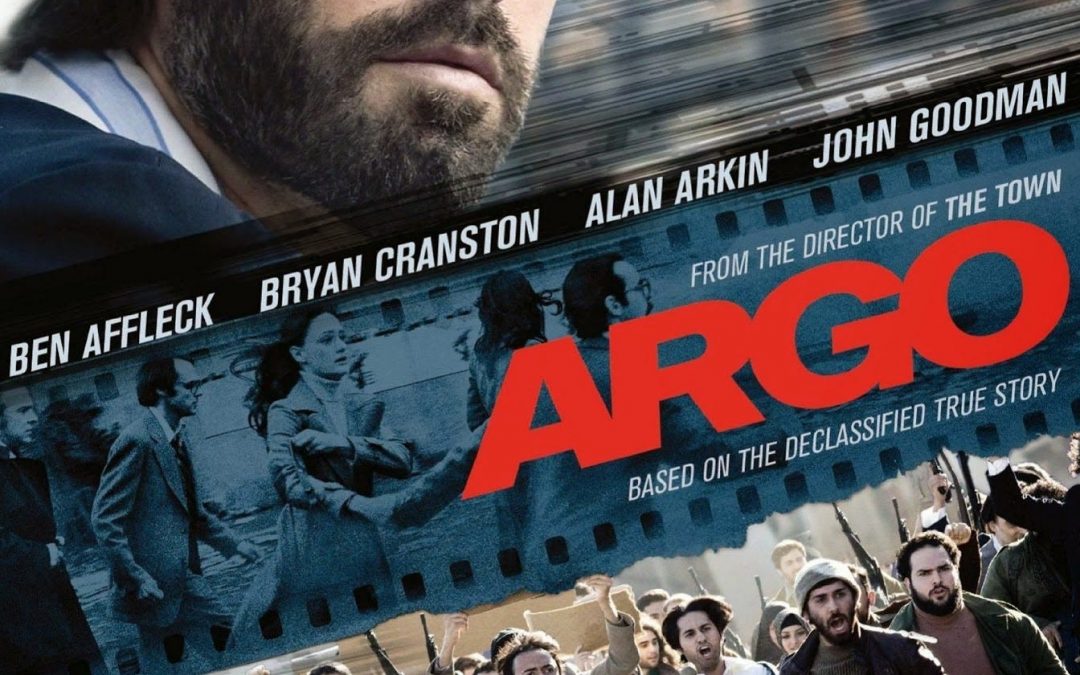Argo is an American biographical historical drama thriller film directed, produced by, and starring Ben Affleck released in 2012. The movie is about the Iranian hostage crisis that occurred in 1979. It focuses on the six escapees and the rescue mission that is executed to bring them back as the six are stuck in the country due to the hostage crisis, unable to stay due to the threat of persecution yet unable to leave the country without the high risk of being captured.
On November 4, 1979, Iranian Islamists stormed the United States Embassy in Tehran due to President Carter giving the shah, Iran’s dictator, shelter in the US for cancer treatment. Sixty-six of the embassy staff are taken as hostages. However, six people managed to escape from the building with direct access to the street. Canadian ambassador Ken Taylor allows the six to reside in his home, however Iran is not safe for them to stay. Back in the US, the US State Department begins to discuss a plan to retrieve the six from Iran. They decide to bring in Tony Mendez, a US Central Intelligence Agency exfiltration specialist, for consultation. As they list options, he criticizes all the proposals but is unable to come up with any better plan. While on the phone with his son, he suddenly comes up with the idea to create a cover story inspired by the show his son is watching, Battle for the Planet of the Apes. The plan is to disguise them all as Canadian filmmakers in Iran scouting “exotic” locations for a science-fiction film. Mendez contacts John Chambers, a Hollywood make-up artist who had previously worked for the CIA. Mendez is put in touch with Lester Siegel, a film producer. They work together to set up a fake film production company, publicize their plans, and create a fake movie known as Argo, a “science fantasy adventure” in the style of Star Wars. Back in Iran, revolutionaries reassemble shredded embassy photographs, discovering that six people have escaped, and the country is no longer safe for them to stay.
Mendez enters Iran under the alias of Kevin Harkins as Argo’s film producer and meets with the six escapees. He gives them forged Canadian passports and fake identities. The six reluctantly go along with his plan, knowing that they are unable to trust him but realizing he is risking his own life as well. They all plan a scouting visit to the bazaar to maintain their cover story, which takes a bad turn when harassed by a hostile shopkeeper.
Mendez is told the operation has been canceled and replaced with a planned military rescue of the hostages. He decides it is too late to turn back and pushes ahead, forcing his boss Jack O’Donnell to re-obtain authorization for the mission and rebook their canceled plane tickets. At the airport, tension rises as the plane tickets are confirmed at the last minute, and the head guard’s call to the fake production company in Hollywood is answered at the last second. The escapees board the plane, but the airport authorities are alerted about their ruse just as they get on. As the plane takes off, the guards chase them down, and the escapees realize they are not safe until the plane has left Iranian airspace. A flight attendant announces that alcoholic beverages are now allowed on the plane, an indicator that they are no longer in Iranian airspace and can no longer be persecuted. The Canadian ambassador in Iran shuts down the embassy and leaves Iran with his wife as the operation is underway, while the ambassador’s Iranian housekeeper flees to Iraq, as she knew about the Americans yet lied to the revolutionaries to protect them. Just before the credits roll, the film ends by explaining what happened after all the events depicted in the movie, which includes the following: hostages are freed after 444 days in captivity, Mendez and Chambers remain friends until Chambers died in 2001, and Mendez goes back to live with his family in rural Maryland.
I love this movie because it accurately depicts the real-life events of the hostage crisis, and stays very true to the real story. It demonstrates how hard it is for refugees to leave the country and the difficulty of not being able to return home safely. Something very important to note is that the escapee’s situation was a bit different from that of refugees, as the six could return to a country they were accustomed to, the U.S., once they had left Iran, while a refugee is usually forced to assimilate to a new environment. The film has been criticized for having heavily dramatized the end portion to create tension for movie watchers, but a majority of the the film stays very close to the real-life events. This movie is a good demonstration of how hard it is for people under threat by their country to just board a plane and leave, and shows the overall struggle of trying to get out of a country with a lot of risk involved.


Recent Comments